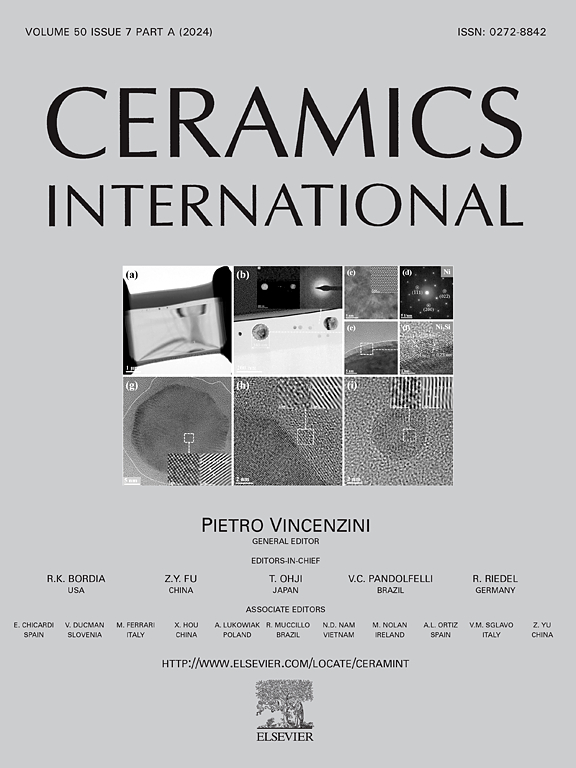Magnetoelectric composite thin films containing multiferroic Bi4Ti3-xNixO12 single-phase and ferromagnetic La0.67Sr0.33MnO3 components
IF 5.6
2区 材料科学
Q1 MATERIALS SCIENCE, CERAMICS
引用次数: 0
Abstract
Magnetoelectric (ME) composite thin films, composed of Ni-doped Bi4Ti3O12 (Bi4Ti3-xNixO12, x = 0.025, 0.05, 0.10 and 0.15) and ferromagnetic La0.67Sr0.33MnO3 (LSMO), were fabricated on LaNiO3-buffered Si substrates using the chemical solution deposition technique. A comprehensive investigation wasconducted to explore the influence of the Ni doping content on multiple properties of the thin films, including their microstructure, ferromagnetism, leakage conduction characteristics, dielectric properties, ferroelectric behavior, and ME coupling performance. Notably, Ni-doping induces the successful transformation of Bi4Ti3O12 from a pure ferroelectric phase to a multiferroic component, and a ME coupling voltage coefficient (αE) value of 0.48 mV/cm·Oe is achieved in the Bi4Ti2.95Ni0.05O12 (BiTiN0.05O) single-phase thin film. Furthermore, as the Ni doping content increases, properties such as leakage conduction, dielectric properties, and ferroelectricity exhibit a trend of first improving and subsequently deteriorating. Among them, the BiTiN0.05O/LSMO composite thin film demonstrates optimal comprehensive dielectric and ferroelectric properties, with a remnant polarization of 23.7 μC/cm2 and a coercive field of 107 kV/cm. Significantly, the BiTiN0.05O/LSMO composite thin film shows an outstanding αE of 330.2 mV/cm·Oe, which is higher than that of many reported ferromagnetic-ferroelectric composite thin films.
含有多铁性Bi4Ti3-xNixO12单相和铁磁性La0.67Sr0.33MnO3组分的磁电复合薄膜
采用化学溶液沉积技术在lanio3缓冲的Si衬底上制备了由ni掺杂Bi4Ti3O12 (Bi4Ti3-xNixO12, x = 0.025, 0.05, 0.10和0.15)和铁磁性La0.67Sr0.33MnO3 (LSMO)组成的磁电复合薄膜。研究了Ni掺杂含量对薄膜微观结构、铁磁性、漏导特性、介电性能、铁电性能和ME耦合性能等多项性能的影响。值得注意的是,ni掺杂诱导Bi4Ti3O12从纯铁电相成功转变为多铁组分,并且在Bi4Ti2.95Ni0.05O12 (bitin0.050 o)单相薄膜中实现了ME耦合电压系数(αE)为0.48 mV/cm·Oe。此外,随着Ni掺杂量的增加,漏导、介电、铁电等性能呈现先改善后恶化的趋势。其中,BiTiN0.05O/LSMO复合薄膜具有最佳的综合介电和铁电性能,残余极化为23.7 μC/cm2,矫顽力场为107 kV/cm。值得注意的是,BiTiN0.05O/LSMO复合薄膜的αE为330.2 mV/cm·Oe,高于许多已报道的铁磁-铁电复合薄膜。
本文章由计算机程序翻译,如有差异,请以英文原文为准。
求助全文
约1分钟内获得全文
求助全文
来源期刊

Ceramics International
工程技术-材料科学:硅酸盐
CiteScore
9.40
自引率
15.40%
发文量
4558
审稿时长
25 days
期刊介绍:
Ceramics International covers the science of advanced ceramic materials. The journal encourages contributions that demonstrate how an understanding of the basic chemical and physical phenomena may direct materials design and stimulate ideas for new or improved processing techniques, in order to obtain materials with desired structural features and properties.
Ceramics International covers oxide and non-oxide ceramics, functional glasses, glass ceramics, amorphous inorganic non-metallic materials (and their combinations with metal and organic materials), in the form of particulates, dense or porous bodies, thin/thick films and laminated, graded and composite structures. Process related topics such as ceramic-ceramic joints or joining ceramics with dissimilar materials, as well as surface finishing and conditioning are also covered. Besides traditional processing techniques, manufacturing routes of interest include innovative procedures benefiting from externally applied stresses, electromagnetic fields and energetic beams, as well as top-down and self-assembly nanotechnology approaches. In addition, the journal welcomes submissions on bio-inspired and bio-enabled materials designs, experimentally validated multi scale modelling and simulation for materials design, and the use of the most advanced chemical and physical characterization techniques of structure, properties and behaviour.
Technologically relevant low-dimensional systems are a particular focus of Ceramics International. These include 0, 1 and 2-D nanomaterials (also covering CNTs, graphene and related materials, and diamond-like carbons), their nanocomposites, as well as nano-hybrids and hierarchical multifunctional nanostructures that might integrate molecular, biological and electronic components.
 求助内容:
求助内容: 应助结果提醒方式:
应助结果提醒方式:


